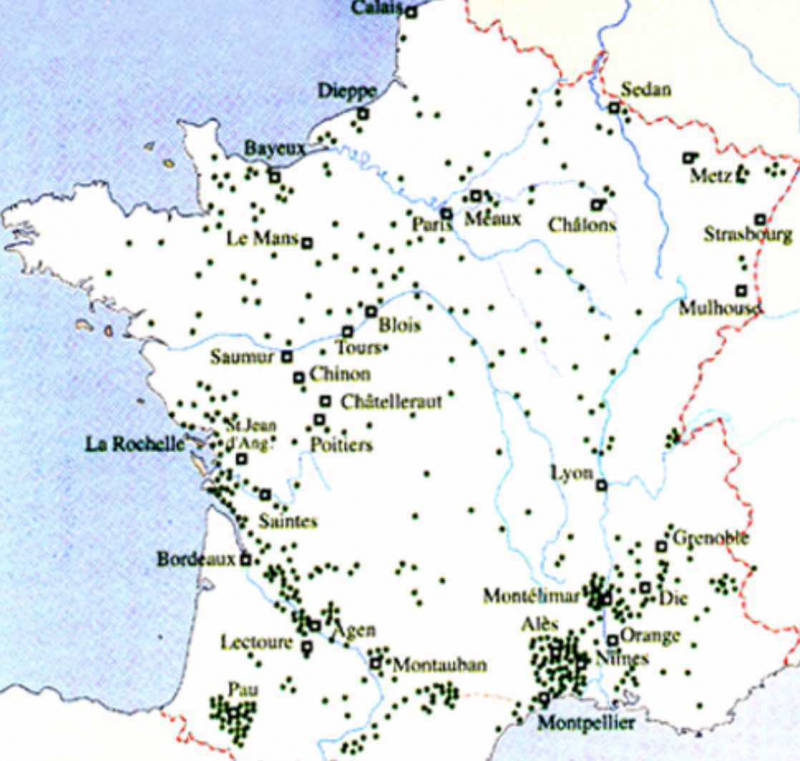
From 1562 Riots of Toulouse – Wikipedia
The history and political structure of Toulouse played a significant part in the tensions that led to the riots in 1562.
Medieval religious past
The city of Toulouse was the capital of Languedoc which had been a stronghold for Catharism throughout the 11th, 12th, and 13th centuries. In an effort to stamp out what it deemed heresy, the Roman Catholic Church had called for military action against the Cathars. These campaigns are grouped under the term the Albigensian Crusade. The Catholic hierarchy also developed the Dominican Order and the Medieval Inquisition in order to expose and eliminate this belief. Some historians, such as Edgar Sanderson,[1] believe that the inroads that the later Reformed Church of France made in the region during the 16th and 17th centuries can be traced to a general questioning of Roman Catholic authority by the people in this region, an attitude that made Catharism so difficult to exterminate. Sanderson notes “In the contest [between Cathars and Catholics] which ensued, sometimes heretics were burnt alive, at other times Inquisitors were driven out or assassinated.”[1]
Also, as a result of the Catholic Church’s sustained focus on the area, great attention was paid to ensure that the population held views seen as acceptable to Catholic orthodoxy, and great efforts were put forward to teach that orthodoxy. These two cultural factors competing in the region (questioning authority and an intense focus on doctrine) may explain how the larger part of the population (including the Parlement) was staunchly Roman Catholic, but the Reformed Church members were able to make quick inroads there.
Rise of Protestantism[edit] By 1530 some within the mendicant orders living in Toulouse and at its university became persuaded by the writings of Martin Luther. By 1532 Catholic authorities began a purge of the university, persecuting and then banishing several students and professors on charges of ascribing to Protestantism.[2] Also in 1532 Toulouse produced one of the first French Protestant martyrs, when the lawyer Jean de Caturce was burnt on a slow fire. This was for making what was termed a “‘Lutheran’ exhortation” while merry-making on the feast of Epiphany (he recommended replacing the prayer “May Christ reign in our hearts!” with “The king drinks!”).[3]
In 1536 copies of John Calvin’s Institution chrétienne were discovered in the city and the Reformed Church of France began to win converts, this despite Toulouse being the seat of Dominican Inquisition.[2] A strange sign of the success for the Reformed Church was when on September 10, 1538 Toulouse’s Catholic Inquisitor of the Faith, Louis Rochette, was strangled and burned at the stake for embracing Protestantism.[2] By the 1540s the struggle between Catholics and Reformed Church members escalated in Toulouse.[2] The Reformed Church members continued their activities in Toulouse for decades despite legal and popular persecution (that sometime escalated into killing).[1] Though the Reformed Church had appeared later in Toulouse than in other provincial capitals (such as Lyons or Rouen), by 1561 they were holding their conventicles close to the Hôtel de Ville (the town hall built in 1190) in the expensive town homes of some of Toulouse’s leading citizens.[4]
Religious riots were breaking out accompanied by bloodshed in Sens, Abbeville, Tours, Marseilles, Toul in Lorraine, and in Cahors and Agen (where Montluc brutally suppressed them). In most cases the Protestants were on the losing end of these conflicts.[13]
Massacre of Vassy[edit] Though the city was about 500 miles north of Toulouse, the Massacre of Vassy that occurred on March 1, 1562 was seen as a dread event by Protestants throughout France. In Languedoc at (Béziers, Cahors, Carcassonne, Castelnaudary and Grenade) spontaneous Protestant revolts occurred upon hearing of the massacre.[4]
The events that led to the Massacre center on Francis, Duke of Guise. The Duke had travelled to Saverne to meet with the Lutheran Duke of Württemberg on February 15, 1562. There Guise worked to convince the German Lutherans that the French Reformed Church and its recognition of Calvin were working against the interests of other Protestants and was able to secure a promise of neutrality should there be armed conflict between the Catholic French and the Reformed Church of France. Upon returning to France, the Duke left Joinville with a contingent of his troops and began to journey towards Paris to rejoin the royal court. As he moved through Vassy on March 1, 1562 his troops encountered a Reformed Church service (which was legal under the terms of the toleration edicts). The interchange between Guise’s troops and the Reformed members resulted in the Massacre of Vassy. The results were the deaths of 63 Reformed Church members and the wounding of hundreds more, along with their church being burnt to the ground.[13]